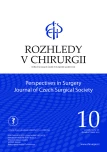Acute appendicitis in supraumbilical hernia
Authors:
M. Puťoš; L. Havlůj
Authors‘ workplace:
Chirurgická klinika Fakultní nemocnice Královské Vinohrady
Published in:
Rozhl. Chir., 2022, roč. 101, č. 10, s. 504-507.
Category:
Case Reports
doi:
https://doi.org/10.33699/PIS.2022.101.10.504–507
Overview
Clinical presentation of acute appendicitis, the most common cause of acute abdomen, is influenced by its location. The usual clinical signs of appendicitis may be completely changed or even absent in cases of atypical appendicular positions. Incisional hernia is the most common late complication of intra-abdominal operations. Organs most likely to be localized in the hernia sac are the omentum and small and large intestines. Occasionally other organs may also herniate, for example, the appendix. Incarcerations of these organs can lead to infarsation or even to gangrene. We present the case of a 59 years old patient who underwent surgical revision for an incarcerated hernia in the scar from his previous laparoscopic operation for bilateral inguinal hernia. We expected to find an incarcerated small intestinal loop in the hernia, but surprisingly we found an acutely inflamed appendix. Considering the inflammation, special care is needed to ensure thorough treatment of the inflammatory process at the site of the incarcerated hernia. This case report presents a rare form of acute appendicitis with atypical localization in the scar from a laparoscopic port; it is a rare combination of two different causes of acute abdomen.
Keywords:
Appendicitis – Hernia – appendix
Sources
1. Hana L, Ryska M, Pohnan R. Acute appendicitis during the spring COVID-19 pandemic in 2020 – a comparative retrospective study. Rozhl Chir. 2021;100(9):429–434. doi:10.33699/ PIS.2021.100.9.429–434.
2. Deshmukh S, Verde F, Johnson PT, et al. Anatomical variants and pathologies of the vermix. Emerg Radiol. 2014;21(5):543–552. doi: 10.1007/ s10140-014-1206-4.
3. Novitsky Yuri W. Hernia surgery. Switzerland, Springer international Publishing 2016. ISBN 978-3-319-27468-3.
4. Dietz UA, Menzel S, Lock J, et al. The treatment of incisional hernia. Dtsch Arztebl Int. 2018;115(3):31–37. doi:10.3238/arztebl. 2018.0031.
5. Galiñanes E L, Ramaswamy A. Appendicitis found in an incisional hernia. J Surg Case Rep. 2012;(8):3–3. doi:10.1093/ jscr/2012.8.3.
6. Becker D, Woodfield J. Complicated appendicitis within an incisional hernia. ANZ J Surg 2018;89(6): E270– E271. doi:10.1111/ans.14339.
7. Sugrue C, Hogan A, Robertson I, et al. Incisional hernia appendicitis: A report of two unique cases and literature review. Int J Surg Case Rep. 2012;4(3):256– 258. doi:10.1016/j.ijscr.2012.12.006.
8. Agarwal N, Goyal S, Kumar A, et al. Appendicitis in paraumbilical hernia mimicking strangulation: a case report and review of the literature. Hernia 2013;17(4):531–532. doi:10.1007/s10029-013-1118-3.
9. Olsen, MA, Nickel KB, Wallace AE, et al. Stratification of surgical site infection by operative factors and comparison of infection rates after hernia repair. Infect Control Hosp Epidemiol. 2015;36(3):329– 335. doi:10.1017/ice.2014.44.
10. Linder S, Linder G, Månsson C. Treatment of de Garengeot’s hernia: a meta-analysis. Hernia 2019;23(1):131–141. doi:10.1007/ s10029-018-1862-5.
11. Cerna M, Sulc R, Kacerovska D. Incisional hernia following laparoscopy, complicated by perforated gangrenic apendicitis – a case review. Rozhl Chir. 2011;90(9):519– 522.
12. Sigley K, Russo T, Welch S. Umbilical hernia containing appendicitis. Cureus 2020; 12(5):e8075. doi:10.7759/cureus.8075.
Labels
Surgery Orthopaedics Trauma surgeryArticle was published in
Perspectives in Surgery

2022 Issue 10
Most read in this issue
- Cholangiocelulární karcinom z pohledu patologa
- Acute appendicitis in supraumbilical hernia
- Prognostic factors of renal cell carcinoma
- Inflammatory cloacogenic polyp in an adolescent – case report and review of the literature
